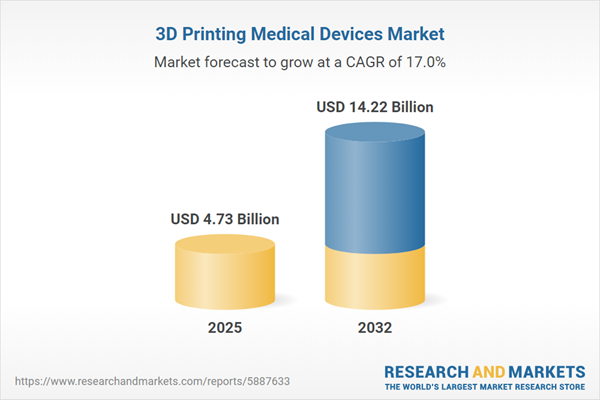Speak directly to the analyst to clarify any post sales queries you may have.
The 3D Printing Medical Devices Market is rapidly transforming healthcare delivery, merging advanced additive manufacturing with clinical needs. This report provides a strategic overview for decision-makers seeking clarity on market direction, innovation drivers, and anticipated challenges in this evolving sector.
Market Snapshot: Size, Growth, and Opportunities
From 2024 to 2025, the 3D Printing Medical Devices Market experienced notable expansion, moving from USD 4.04 billion to USD 4.73 billion and positioning itself for continued robust growth. This trajectory, supported by a compound annual growth rate of 17.00%, projects the market to reach USD 14.22 billion by 2032. Growth is propelled by the demand for patient-specific solutions, rapid prototyping, and advancements in 3D printing technologies.
Scope & Segmentation
This report analyzes the comprehensive landscape of 3D-printed medical devices, examining key applications, enabling technologies, end users, and regional trends.
- Application Areas: Anatomical models, dental devices (aligners, crowns, bridges, dentures), implants (craniofacial, dental, orthopedic), prosthetics, orthotics, and surgical instruments.
- Printing Technologies: Binder jetting, direct metal laser sintering, electron beam melting, fused deposition modeling, selective laser sintering, stereolithography.
- Material Classes: Ceramics, composites, metals, and plastics, each presenting use-case-specific advantages for device performance and biocompatibility.
- End Users: Contract manufacturers, dental clinics, hospitals, research institutes, and laboratories.
- Printer Types: Desktop systems and industrial systems catering to diverse project needs and investment capacities.
- Regional Coverage: In-depth analysis includes the Americas (United States, Canada, Mexico, Brazil, Argentina, Chile, Colombia, Peru), Europe (United Kingdom, Germany, France, Russia, Italy, Spain, Netherlands, Sweden, Poland, Switzerland), Middle East (United Arab Emirates, Saudi Arabia, Qatar, Turkey, Israel), Africa (South Africa, Nigeria, Egypt, Kenya), and Asia-Pacific (China, India, Japan, Australia, South Korea, Indonesia, Thailand, Malaysia, Singapore, Taiwan).
- Key Industry Players: Evaluated companies include 3D Systems, Stratasys, Materialise NV, EOS GmbH, EnvisionTEC GmbH, SLM Solutions Group, GE, Formlabs, Carbon, and Renishaw plc.
Key Takeaways for Senior Decision-Makers
- The convergence of additive manufacturing and healthcare is enabling highly personalized medical devices and reshaping traditional production models.
- Innovative materials such as antimicrobial polymers, bioresorbable ceramics, and advanced alloys are broadening the clinical applications and performance of 3D-printed devices.
- Integrated digital workflows now link imaging, design, and print production, streamlining customization and accelerating product development.
- Diverse printing methods allow for tailored clinical solutions, from rapid surgical simulation models to patient-matched implants.
- Collaborations between industry, academia, and healthcare institutions are critical for mitigating risk, validating new products, and achieving regulatory compliance.
- Emerging regions are prioritizing skill development and infrastructure to unlock new market potential, while advanced markets benefit from mature regulatory systems.
Tariff Impact: Strategic Considerations
Recent tariff actions in the United States have altered cost structures for imported 3D printing machinery and raw materials, including metal powders and specialized resins. These changes are influencing procurement strategies, prompting a notable shift toward localizing production and forming collaborative partnerships to share development costs. This new environment requires adaptive planning to balance innovation investment with affordability in a dynamic regulatory landscape.
Methodology & Data Sources
The research employs a mixed-methods approach, integrating expert interviews across manufacturers, suppliers, and key clinical stakeholders. Quantitative surveys and supply chain mapping complement these insights. Secondary sources, including journals, patent filings, and regulatory documents, are critically reviewed, with data triangulation ensuring consistency and credibility in findings.
Why This Report Matters
- Gain clear visibility into technology adoption, evolving market structure, and competitor strategies within the 3D Printing Medical Devices Market.
- Leverage segmentation and regional analysis to inform new product planning and market entry strategies.
- Identify key drivers, risks, and collaborative models to support informed, long-term strategic decisions.
Conclusion
The 3D Printing Medical Devices Market stands at the intersection of innovation, collaboration, and evolving clinical requirements. Decision-makers will find critical insights in this report to guide growth strategies and capitalize on opportunities in a dynamic global market.
Additional Product Information:
- Purchase of this report includes 1 year online access with quarterly updates.
- This report can be updated on request. Please contact our Customer Experience team using the Ask a Question widget on our website.
Table of Contents
3. Executive Summary
4. Market Overview
7. Cumulative Impact of Artificial Intelligence 2025
Companies Mentioned
The companies profiled in this 3D Printing Medical Devices market report include:- 3D Systems, Inc.
- Stratasys Ltd.
- Materialise NV
- EOS GmbH Electro Optical Systems
- EnvisionTEC GmbH
- SLM Solutions Group AG
- General Electric Company
- Formlabs, Inc.
- Carbon, Inc.
- Renishaw plc
Table Information
| Report Attribute | Details |
|---|---|
| No. of Pages | 192 |
| Published | November 2025 |
| Forecast Period | 2025 - 2032 |
| Estimated Market Value ( USD | $ 4.73 Billion |
| Forecasted Market Value ( USD | $ 14.22 Billion |
| Compound Annual Growth Rate | 17.0% |
| Regions Covered | Global |
| No. of Companies Mentioned | 11 |









